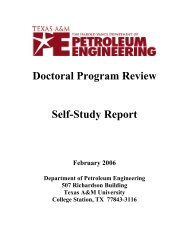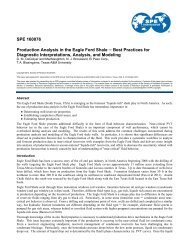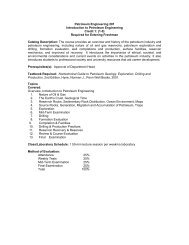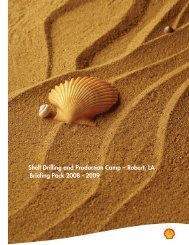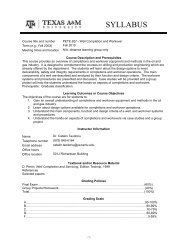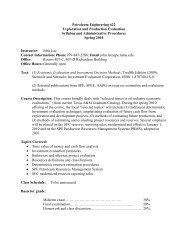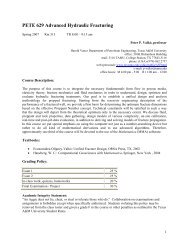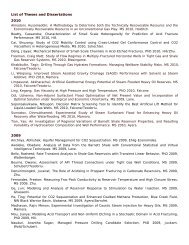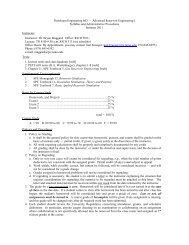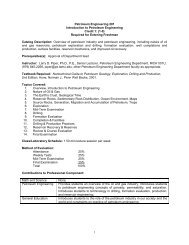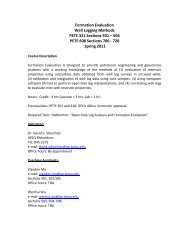Crisman Annual Report 2009 - Harold Vance Department of ...
Crisman Annual Report 2009 - Harold Vance Department of ...
Crisman Annual Report 2009 - Harold Vance Department of ...
Create successful ePaper yourself
Turn your PDF publications into a flip-book with our unique Google optimized e-Paper software.
The falling body viscometer is selected to measure gas<br />
viscosity for a pressure range <strong>of</strong> 3,000 to 24,500 psia<br />
and temperature range <strong>of</strong> 100 to 415°F. Nitrogen was<br />
used to calibrate the instrument and to account for<br />
the fact that the concentrations <strong>of</strong> non-hydrocarbons<br />
are observed to increase dramatically in HPHT<br />
reservoirs. Then methane viscosity is measured to<br />
reflect the fact that, at HPHT conditions, the reservoir<br />
fluids will be very lean gases, typically methane with<br />
some degree <strong>of</strong> impurity. The experiments showed<br />
that while the correlation <strong>of</strong> Lee et al. accurately<br />
estimates gas viscosity at low to moderate pressure<br />
and temperature, it does not provide a good match<br />
to gas viscosity at HPHT conditions.<br />
higher than the values provided by the NIST and<br />
by previous investigators. The difference increases<br />
as temperature decreases, and it increases as<br />
pressure increases. These preliminary results stress<br />
the importance <strong>of</strong> obtaining an exhaustive range<br />
<strong>of</strong> measurements <strong>of</strong> the viscosity <strong>of</strong> natural gases<br />
under HPHT conditions in order to ensure better<br />
reserves estimation. To this aim, further tests are<br />
ongoing at Texas A&M University.<br />
Accomplishments<br />
Comparing our result with NIST values and data at<br />
low to moderate pressure and temperature from<br />
previous investigators showed that:<br />
» Nitrogen viscosity—The lab data matched the<br />
NIST values as well as those reported by other<br />
investigators at low to moderate pressures, while<br />
they are lower at high pressure. The difference<br />
between measured data and NIST values increases<br />
as temperature decreases; this difference also<br />
increases as pressure increases.<br />
» Methane viscosity—New lab data matched the<br />
NIST values at low to moderate pressure, but the<br />
new experimental viscosities are higher at high<br />
pressure. The mismatch decreases as temperature<br />
increases, and increases as pressure increases.<br />
Significance<br />
Gas viscosity correlations derived from data obtained<br />
at low to moderate pressures and temperatures cannot<br />
be confidently extrapolated to HPHT conditions. The<br />
gas viscosity correlations that are currently available<br />
to the petroleum industry were derived from data<br />
obtained with gases with limited impurities, and so<br />
their accuracy for use with gases containing large<br />
quantities <strong>of</strong> impurities is unknown.<br />
The laboratory investigations performed at TAMU<br />
show that, at high pressure, the experimental<br />
nitrogen viscosities are lower than the values<br />
provided by the NIST and by previous investigators.<br />
The observed mismatch increases as temperature<br />
decreases, and it increases as pressure increases.<br />
For methane, the TAMU investigations show that,<br />
at high pressure, the experimental viscosities are<br />
74<br />
<strong>Crisman</strong> <strong>Annual</strong> <strong>Report</strong> <strong>2009</strong>



